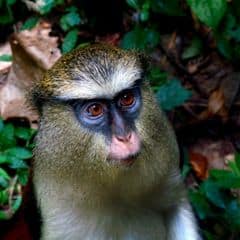
| Animalia | Primates | Cercopithecidae | Chlorocebus | Chlorocebus tantalus |


- Common Name: Tantalus Monkey
- Taxonomy Classification Year: 1841
- Monkey Size: 42.6 to 49 cm (17 to 19 in)
- Skin Color(s): Yellowish brown
- Habitat: Forest, rainforest
- Diet: Omnivorous
- Native Countries: Benin, Burkina Faso, Cameroon, Central African Republic, Chad, Democratic Republic of Congo, Ghana, Kenya, Niger, Nigeria, Sudan, Togo, Uganda
Tantalus Monkey Distribution
Tantalus Monkey Characteristics

The tantalus monkey[1] (Chlorocebus tantalus) is an Old World monkey endemic to Africa, ranging from Ghana to Sudan.
- It was initially described as a subspecies of Grivet (Chlorocebus aethiops). However, all species of Chlorocebus belonged to the Cercopithecus genus.
- Tantalus monkeys are very similar to vervet monkeys but are smaller in size. Their dark eyes are barely distinguishable from their black faces.
- Long white hair radiates from their cheeks and temples, partially covering their ears. A half crown of shorter white hair ruffles their eyebrows.
- The yellowish-brown fur extends from the head, shoulders, and buttocks to the top of the long tail.
- The fur on its arms and legs is grayer than the rest of its body. The skin on their hands and feet matches their face.
- Females are significantly smaller than males and have a white coat that covers their abdomen.
- The undersides of males are also primarily white, except for the orange hairs around their light blue testicles.
What Do Tantalus Monkeys Eat?

The Tantalus Monkey nourishes on Velvet Tamarind (Dialium guineense) and Kapoktree (Ceiba pentandra)[¶].
What Eats Tantalus Monkeys?

Spotted Hyenas (Crocuta crocuta) are the primary predators of tantalus monkeys[§].
Tantalus Monkey Facts

- Tantalus monkeys spend most of the day on the ground foraging for food, traveling up to 3 km per day.
- Their habit of wandering between forest patches makes tantalus monkeys essential seed dispersers.
- Their cheeks are equipped with special pouches in which they store snacks, which is practical when moving between feeding sites.
- In trees, their movements are somewhat more restricted than other monkey species. They never jump or hop between branches.
- Because they can live in various habitats (including cities), their primary survival need seems to be direct access to fresh water, which they must drink regularly, or they will become dehydrated.
Suggested Reading: All Types of Monkeys
Cite This Page
APA7MLA8Chicago
BioExplorer.net. (2025, May 28). Tantalus Monkey. Bio Explorer. https://www.bioexplorer.net/animals/mammals/monkeys/tantalus-monkey/.
BioExplorer.net. "Tantalus Monkey" Bio Explorer, 28 May 2025, https://www.bioexplorer.net/animals/mammals/monkeys/tantalus-monkey/.
BioExplorer.net. "Tantalus Monkey" Bio Explorer, May 28 2025. https://www.bioexplorer.net/animals/mammals/monkeys/tantalus-monkey/.











